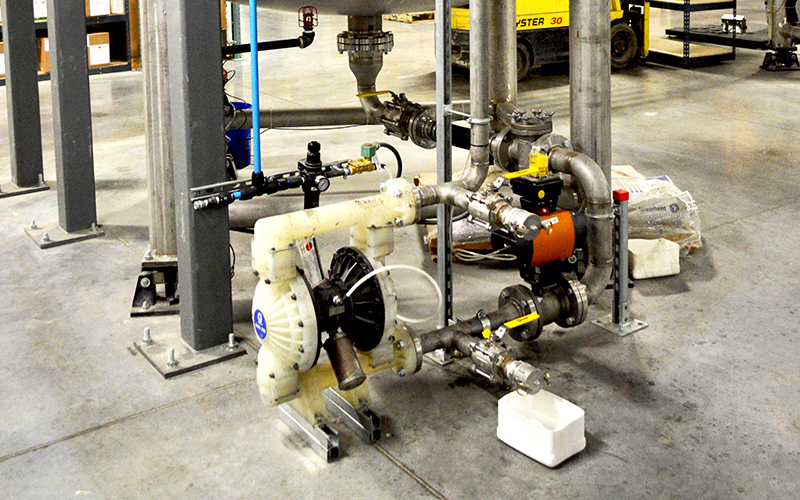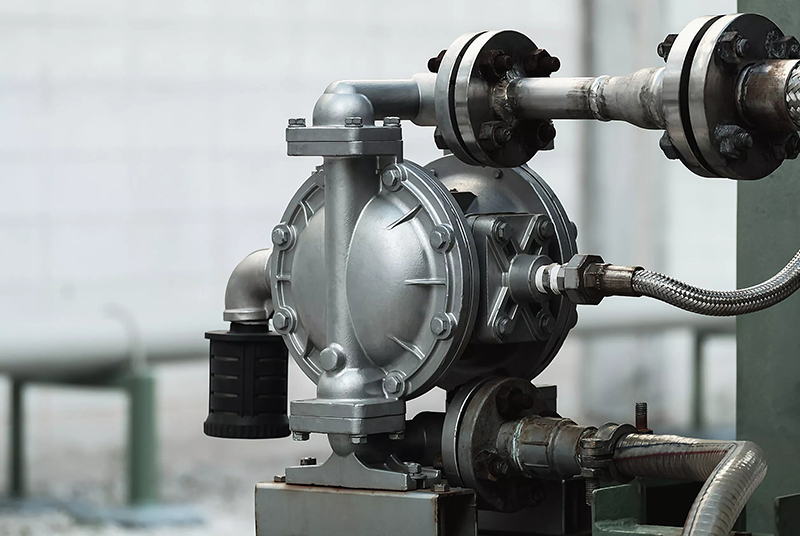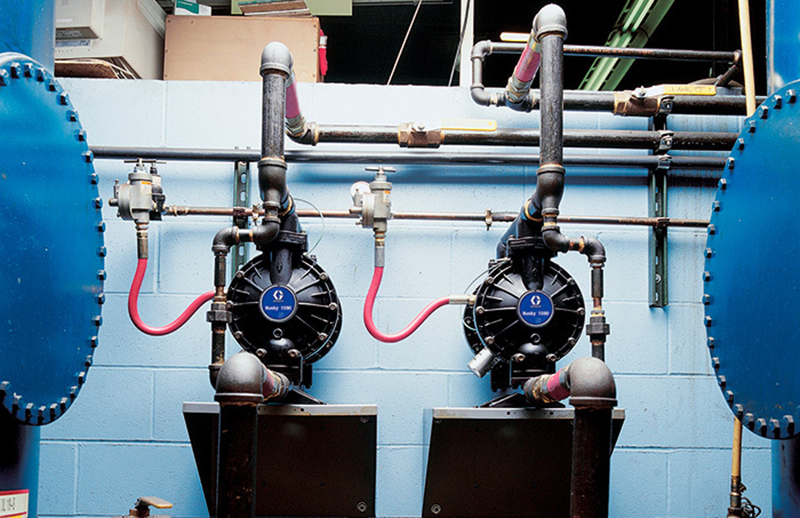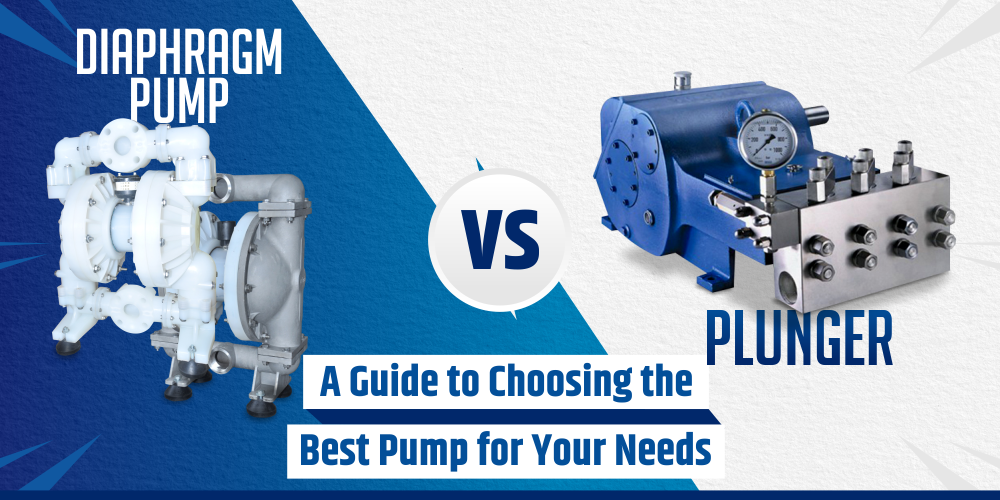Diaphragm pump are typically used for low-pressure applications, such as chemical dosing, food processing, and medical equipment.
Plunger and diaphragm pumps are commonly used in industrial and commercial applications. These pumps are designed to move fluids by trapping fluid and then discharging it under pressure.
A plunger pump is a reciprocating pump that uses a plunger or piston to displace the fluid. The plunger is pushed back and forth within a cylinder, creating pressure that forces the fluid through the pump and into the discharge line. Plunger pumps are typically used for high-pressure applications, such as water blasting, car washes, and the oil and gas industry.
The diaphragm is positioned between the pump chamber and the fluid to be pumped, and as it flexes, it creates a vacuum and suction that draws the fluid into the pump. Diaphragm pumps are typically used for low-pressure applications, such as chemical dosing, food processing, and medical equipment.
In this blog, we will provide a brief and simple explanation of the workings of each pump design. Following this, we will detail the advantages and disadvantages of the plunger and diaphragm pumps and guide how to determine which type is most suitable for your equipment.
Operational Principle of Plunger Pumps
A plunger or piston moves reciprocally in plunger pumps, propelling liquids through several valves. Some common daily examples include a spray bottle, squirt gun, or bicycle pump.
In the commercial sector, plunger pumps find widespread usage in high-pressure applications such as soft washing, pest control, agriculture, disinfection, and portable sanitation. In addition, they are adaptable to electrically operated equipment such as sprayers, misters, and pressure washers.
Operational Mechanism of Diaphragm Pumps
High-pressure Plunger pumps and diaphragm pumps share some similarities as they reciprocate pumps. However, in a diaphragm pump, the tip of the plunger is linked to a pliable membrane that oscillates. In nature, the human heart is a diaphragm pump that occurs naturally.
In commercial applications, diaphragm pumps are frequently employed for fluid transfer and dewatering and are ideal for low PSI conditions. As a result, some commercial manufacturers integrate them into spray equipment, but they may only sometimes be suitable for such applications.

Advantages and Disadvantages of Plunger and Diaphragm Pumps
One significant contrast between plunger and diaphragm pumps is their energy source. Diaphragm pumps can be designed to run on a gas-powered engine or an electric motor. However, a gas-powered diaphragm pump is necessary for most professional applications to achieve the requisite output and power. On the other hand, electric diaphragm pumps are typically intended for low-impact uses, such as small hand-held sprayers and RV sinks, and are sold for residential purposes.
Manufacturers offer commercial plunger and piston pumps that are available as either gas-powered or 12V battery-powered units. Unlike diaphragm pumps, Pumptec and other companies can design their electric, battery-powered plunger pumps to perform at par with or even better than gas-powered diaphragm pumps in harsh commercial settings.
Now we will be examining and comparing commercial electric plunger pumps and gas-powered diaphragm pumps in the following categories:
- Spray Patterns and Flow
- High-Pressure Capabilities
- Size
- Priming
- Run Times
- Environmental Impact
- Noise Levels
- Cost

Spray Patterns and Flow
Plunger pumps maintain a steady flow rate with the help of rigid components. This ensures that liquids are distributed evenly and consistently, providing uniform coverage.
On the other hand, diaphragm pumps have flexible components that result in an inconsistent flow rate. As a result, they are known for losing pressure and creating irregular spray patterns, a significant issue for applications that involve harsh chemicals in heavily regulated industries like disinfection, soft wash, fertilizer applications, and more.
High-Pressure Capabilities
To avoid issues caused by the flexible components in diaphragm pumps, it’s important to consider the required pressure for your application. Over time, the flexible diaphragm of a diaphragm pump can rupture under higher pressure. In contrast, plunger pumps are designed to withstand repeated high-pressure use. If you frequently have to issue refunds or warranty replacements for diaphragm pumps used in high PSI equipment, switch to a more durable plunger pump.
Size
Compact and highly maneuverable, battery-powered plunger pumps are much easier and safer than their gas-powered diaphragm counterparts. If you need a smaller pump that can fit more easily into your equipment, then the plunger pump is the way to go. Plunger pump batteries are roughly the size of a marine battery.

Priming
Unlike centrifugal pumps, plunger pumps and diaphragm pumps are self-priming, which requires priming to prevent them from becoming inoperative due to air in the pump chamber.
Run Times
In recent years, battery technology has progressed remarkably. Modern 12V plunger pump systems incorporate batteries that outperform the capacity of numerous gas-powered diaphragm pump engines. As a result, the operator doesn’t need to stop work midway to refuel, and safety is enhanced by eliminating the need to transport volatile substances.
Apart from battery technology, the primary reason why electric plunger pumps can compete with gas-powered pumps is their innate efficiency. Operators can complete a day’s work on a single charge and recharge batteries while traveling between jobs.
Environmental Impact
The utilization of 12V battery-powered equipment provides the advantages of eco-friendly technology. In addition, the rising concerns regarding volatile gas prices, oil reliance, and pollution make the latest 12V plunger pump technology an environmentally conscious power source.
In addition, electric plunger pumps conform to the regulations in states where small off-road gas-powered engines are prohibited. Equipment manufacturers, who are proactive in sensing this trend, are already developing equipment that meets the demand for electric high-pressure pumps in these states.
Noise Levels
A 12V motor-driven system operates much more silently than gas-powered engines. So if you’re a pest control provider and your clients prefer to avoid attracting attention, a 12V pump system is the way to go.
The quiet operation is also beneficial for lawn care and soft wash professionals since it increases the available hours for service. Noise regulations may restrict the operation hours of gas engine diaphragm pumps, but a 12V plunger pump system is not subject to such limitations.

Cost
The ongoing fuel purchase and higher equipment costs make gas engines more expensive than batteries. Batteries are rechargeable and have a consistent price. Even though the initial cost of a diaphragm pump may be lower, a battery-operated plunger pump will likely have a much lower cost of ownership.
Equipment manufacturers will receive fewer complaints and warranty claims, and operators can reduce fuel consumption while experiencing fewer breakdowns, repairs, and periods of downtime.
Conclusion
The choice between a plunger pump and a diaphragm pump ultimately depends on the specific needs and requirements of the user. Both pumps have advantages and disadvantages, and it’s important to consider factors such as spray patterns and flow, priming, high-pressure capabilities, noise levels, run times, size, environmental impact, and cost before deciding.
Battery-powered plunger pumps have become popular due to their environmental benefits, lower cost of ownership, and quieter operation. However, gas-powered diaphragm pumps are still a viable option for certain applications. By carefully evaluating your needs and considering the pros and cons of each pump, you can make an informed decision and choose the best pump for your needs.
Comments are closed.

